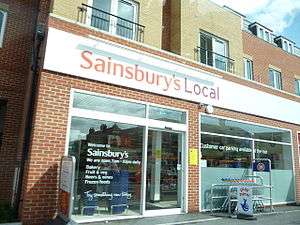Sainsbury's Local

Sainsbury’s Convenience Stores Limited (trading as Sainsbury’s Local) is a chain of 770 convenience stores operated by the UK's second largest supermarket chain Sainsbury's.[1] Sainsbury's Local stores have different branding and fascia to the company's supermarkets.
History
In 1998, Sainsbury’s piloted its first Local store in Hammersmith. The store opened on the busy Fulham Palace Road, and was designed for the convenience of customers who did not have time to do a full food shop. Research showed that people were working longer hours and more women were in employment than ever before. Customers needed to spend less time on chores such as shopping, so local ‘top-up’ shopping was an ideal solution. As well as a large range of ready meals, wines and desserts designed for people on-the-go, the branch also offered hot drinks and freshly baked goods, alongside Sainsbury’s best selling products. The Hammersmith store also had a cash machine and opened until midnight most days of the week.
The Sainsbury’s Local store was also ground-breaking in terms of staff training. In most Sainsbury’s stores, colleagues were trained for specific departments (e.g. checkouts, cafe, fresh foods, GM). The small size of Sainsbury’s Local stores meant that staff needed a high level of product knowledge across all departments. Keeping in line with the ‘Local’ concept, the Hammersmith store also employed only local people.[2]
Joint venture with Shell
In June 2003, Sainsbury’s announced that it was creating 100 new convenience stores at Shell petrol stations. The shops were to open over the next three years, leading to the creation of up to 2000 jobs.
The first of the stores opened in the autumn of that year, following a successful trial at six garages in south east England. The new stores were based on the existing "Sainsbury Local" outlets, but also sold car care products and motor accessories.
In the end, only 24 stores were opened.[3] The joint venture has now ended due to being unprofitable.
Acquisitions
Following rival Tesco’s purchase of the convenience store chain T&S Stores in 2002 and the subsequent conversion of 450 of the 870 T&S stores into its Tesco Express convenience stores, Sainsbury’s announced the acquisition of a number of convenience store chains:
Bells Stores
In February 2004, Sainsbury’s announced it was to buy Bells Stores in the North East of England for around £22m. Bells Stores operated 54 neighbourhood stores, and was owned and run by the Bell family. The stores were initially refurbished to trade as ‘Sainsbury’s at Bells’.[4]
Jacksons Stores
In August 2004 Sainsbury’s further increased its presence in the convenience store sector, by acquiring Jacksons Stores for £78m from the family food business William Jackson & Son Ltd, owned by the Oughtred family. Jacksons Stores had 114 stores in the Yorkshire area and the North Midlands, and just before the Sainsbury’s acquisition, was voted the UK’s best independent convenience store chain. The acquisition doubled Sainsbury’s market share in the convenience store sector to 2%. The stores were initially refurbished to trade as ‘Sainsbury’s at Jacksons’.[5]
J B Beaumont
In November 2004, Sainsbury’s acquired JB Beaumont, a convenience chain owned and run by the Beaumont family and which was then number 48 in the Grocer Top 50. The company first began trading as a butcher in Kirkby-in-Ashfield (Nottinghamshire) in 1902. The six JB Beaumont stores were located in Cotgrave; Bingham; Keyworth; Long Eaton; Chilwell and Gedling. The stores were initially refurbished to trade as ‘Sainsbury’s at Beaumonts’.[6]
S L Shaw
In April 2005, Sainsbury’s acquired SL Shaw Ltd, a neighbourhood convenience store operator with five stores in the south east of England. After a programme of refurbishment, the five stores converted to the Sainsbury’s Local format, combining Shaw’s reputation and customer service with Sainsbury’s expertise in fresh and convenience foods.[7]
Branding
Sainsbury's initially retained the strong Bells and Jacksons brands. For example, refurbished stores were called Sainsbury's at Bells or Sainsbury's at Jacksons. These were effectively Sainsbury's Local stores with a revised fascia, retaining some features of the former local chain. Unrefurbished stores retained the original brand and logo, but still offered Sainsbury's own brand products, pricing and some point of sale, without accepting Nectar cards. The old websites were also retained with some Sainsbury's branding.
This was an experimental format and on 4 May 2007 it was announced that all stores would be re branded as Sainsbury's Local, with the management teams of the smaller stores integrated into Sainsbury's own teams.[8]
Sainsbury's Central
A second convenience format, Sainsbury's Central, was used for small to mid-sized stores in town centres and commuter areas; the Central stores have an offer dominated by food-to-go and convenience foods, but also carry selected ranges from mainline stores. Sainsbury's has announced plans to phase out Central as a store brand, and rename these sites simply as Sainsbury's, though some stores are still to be refurbished and converted.
Plans
On 12 November 2008 Sainsbury's announced that 50 convenience stores would open in the 2009/10 financial year, and a further 100 the following year.[9]